Letters from Lodi
An insightful and objective look at viticulture and winemaking from the Lodi
Appellation and the growers and vintners behind these crafts. Told from the
perspective of multi-award winning wine journalist, Randy Caparoso.
Lodi's annual Tour of Tempranillo, and everything you need to know about this emerging varietal red
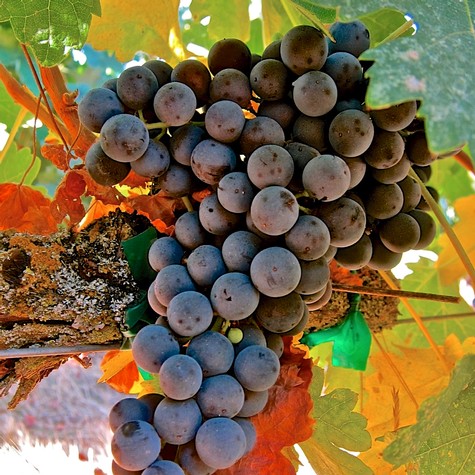
Ribera del Duero clone Tempranillo in Lodi's Bokisch Vineyards.
Be sure to mark down the weekend of November 13-14, 2021 for Lodi's sixth annual Lodi Tour of Tempranillo.
This year nine of the Lodi region's wineries that specialize in Tempranillo will open their doors for this self-guided tour. It's a special event because Tempranillo, a grape that originated in Spain and is generally considered the country's finest red wine variety, has found a natural home in Lodi's Mediterranean climate and grape-friendly soils. In short, Tempranillo produces first-class red wines, as fine as any in the world, and certainly as fine as any in Lodi.
You can learn how to join in on the local festejos by visiting the Tour of Tempranillo website at www.lodispanishwinetour. The idea is to map out your own route. Take your time, enjoy the scenery, savor, and chat about these special wines, some of them phenomenal.
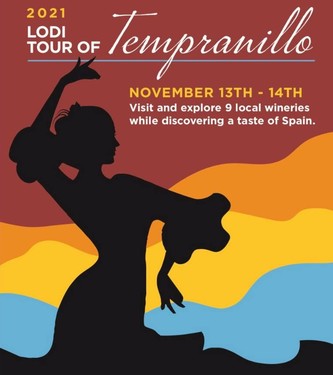
You can kick off your Lodi Tempranillo experience by picking up a guidebook (no fee to embark on the tour!) at any of the participating wineries. Each winery's activities will range from special barrel tastings to vertical tastings, food pairings, live music, library wines, raffles, and special offerings of wines for purchase. Shout it out with #LodiTourOfTempranillo #InternationalTempranilloDay #Tempranillo.
The nine participating Lodi-based wineries:
Bokisch Vineyards, 18921 Atkins Rd., Lodi, CA
Dancing Coyote, 3125 E. Orange St, Acampo CA
Drava Wines, 1378 E. Turner Road, Suite D, Lodi, CA
Field Family Wines, 3803 Woodbridge Rd E, Lodi CA
Heritage Oak Winery, 10112 E Woodbridge Rd, Lodi CA
McCay Cellars, 18817 E. Hwy. 88, Clements, CA
McConnell Estates, 10686 W Stockton Blvd, Elk Grove, CA
Riaza Wines, 2441 S Stockton St, #1, Lodi, CA
St Amant Winery, 1 Winemaster Way #1, Lodi CA
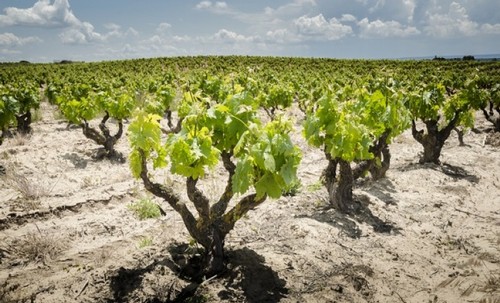
Old World-style Tempranillo vineyard in Spain's Ribera del Duero region. winedharma.com.
Everything you need to know about Tempranillo (and more!)
So let's geek out on the grape itself, a black-skinned variety native to Spain. The information on how long grapes with the exact same DNA as today's Tempranillo cultivars have been cultivated in Spain and Portugal is sketchy, but Roman historians reported that wine grapes were grown all over Spain in the first century AD, and there is archeological evidence of winemaking in Spain dated back some 2,000 years.
What we do know is that there are currently over 500,000 acres of Tempranillo cultivated in Spain. To put that figure in perspective, according to the most recent USDA report, there are about 620,000 acres of wine grapes planted in all of California. California's leading grapes include Cabernet Sauvignon (94,670 acres), Chardonnay (90,684 acres), Pinot noir (48,041 acres), Merlot (35,962 acres), and Zinfandel (39,578 acres) — suffice to say, all peanuts compared to Spain's 500,000-plus acres of Tempranillo alone.
Tempranillo, in fact, is currently the fourth most widely planted wine grape in the world. Over 87% of it is planted in Spain. California? Right now, a total of 914 acres. Interestingly, Tempranillo has also been showing very promising results in Southern Oregon, where there are currently just over 400 acres planted.
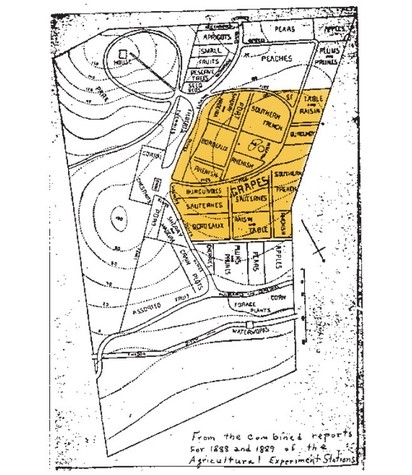
1888/1889 map of the University of California's Foothill Experiment Station in Jackson, California where Valdepeñas (a clonal variant of Tempranillo) was cultivated. U.C. Davis Foundation Plant Services.
Despite its enormous importance in Europe, obviously, Tempranillo has a long way to go before catching on with American consumers. Although it's been only within the past 20 years that most American wine lovers have even heard of the variety, we know from historical accounts that the grape was first introduced to California during the late 1800s, and first known as Valdepeñas. According to the U.C. Davis Foundation Plant Services page:
This grape was brought to California in the late 19th century under the name Tinta de Valdepeñas. It is thought that the University named the grape after the place in Spain from which it obtained the plant material. The selection was planted in the 1880s at the University of California's former Foothill Experiment Station in Jackson, California. DNA testing on this California variety, which came to be known as Valdepeñas, shows that it matches Tempranillo. The name Valdepeñas was maintained for this Tempranillo grape at U.C. Davis for historical purposes.
Thus, for most of the twentieth century, Tempranillo has been listed in California and USDA grape acreage and crush reports as Valdepeñas. Whatever its moniker, it was considered a very minor variety — primarily because most of it was planted in warmer regions (i.e., south of Lodi) of the Central Valley, where it produced nondescript wines going into “jug” generic blends and fortified bottlings.
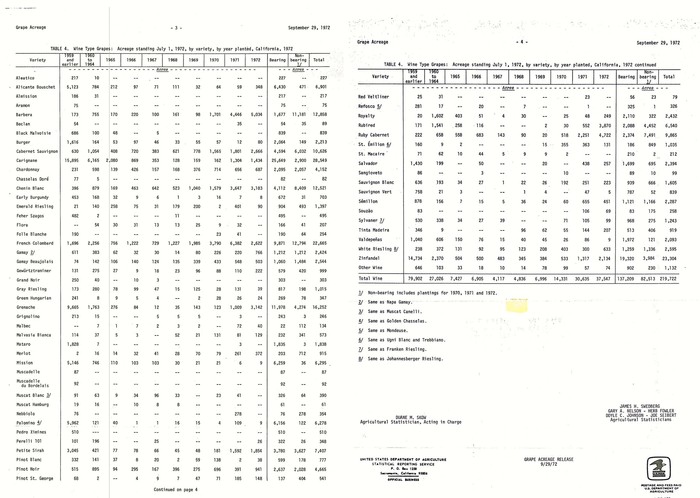
Listing of planted wine grapes from the University of California's 1972 Grape Acreage Report. UCCE California San Luis Obispo.
According to the 1972 University of California Grape Acreage Report, for instance, a total of 219,722 acres of wine grapes were planted in the entire state. In those days, Carignan (a big component in jug reds) was California's leading wine grape, with 28,549 acres. At the time, there were only 10,525 acres of Cabernet Sauvignon planted; but also, a fairly respectable amount of Valdepeñas, with 2,093 acres (more than twice as much as all the Tempranillo planted in California today!).
Why did Valdepeñas/Tempranillo go unappreciated in California for over a century? In all likelihood, it is because the grape never developed a reputation in the American wine industry as a variety possessing clearly defined sensory qualities. Typifying the thinking of the California wine industry, in Maynard Amerine and Edward Roessler's authoritative 1963 book called Wines, Their Sensory Evaluation (W.H. Freeman and Company), the black-skinned grapes listed as having "recognizable varietal character" were Barbera, Cabernet Franc, Cabernet Sauvignon, Gamay (a.k.a., Valdiguié), Grignolino, Merlot, Nebbiolo, Petite Sirah, Pinot noir, Ruby Cabernet and Zinfandel.
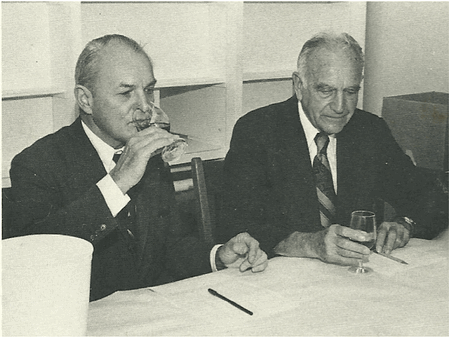
Legendary U.C. Davis professors/authors Maynard A. Amerine and Edward B. Roessler.
To add insult to injury, Amerine and Roessler went on to mention varieties "that rarely yield wines with a recognizable varietal character," listing Carignan, Early Burgundy (a.k.a., Abouriou), Mataró (a.k.a. Mourvèdre), Mondeuse, Royalty, and Rubired as belong to that category. But absolutely no mention of Tempranillo or Valdepeñas anywhere. At the beginning of the modern-day varietal wine boom, which started in the 1960s and 1970s, Tempranillo was never even thought of as a grape that might play a part in California's table wine industry.
Admittedly, even the finest Tempranillo-based reds of the world — not just those of California and Oregon, but also classic regions like Spain's Rioja and Ribera del Duero regions — do not have the obvious, fragrant fruit perfumes of grapes like, say, Pinot noir or Zinfandel, nor the pungent dark berry profiles of a Cabernet Sauvignon or Merlot. The aromas of top Tempranillo reds are always much more subtle: more like hints or subtle suggestions of berryish fruit, more often than not encased in equally faint notes of leather, tobacco, red meat, and/or earthy nuances.
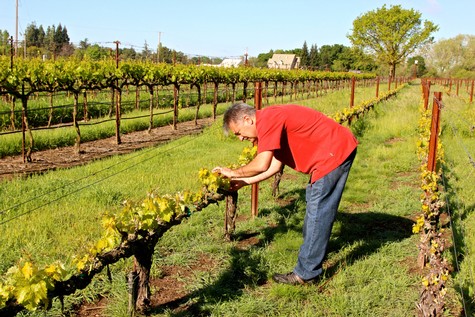
Bokisch Vineyards owner/grower Markus Bokisch with close-space trellised Tempranillo in his "mother block," called Las Cerezas Vineyard.
It is not surprising, given the average American wine consumer's penchant for more obvious fruit qualities in wine, that it wasn't until the early 2000s that American-grown Tempranillo bottlings finally caught on with modest numbers of wine lovers in search of alternative varietals; especially when consumers began to appreciate the taste of Spanish imports made from the Tempranillo grape.
Once a small yet significant chunk of American consumers developed a taste for red wines with lower-key aromas and flavors — i.e., a more "European" taste, the opposite of the easily identified fruit profiles appealing to most American consumers — it was only a matter of time, during the late 1990s, before pioneering American grower/producers of Tempranillo, such Abacela Vineyards in Southern Oregon and Bokisch Vineyards in Lodi, would be able to gain significant toeholds as leaders in their respective markets.
Lodi's Markus Bokisch broke ground on his Bokisch Vineyards in 1996. He felt that one of his first plantings of Spanish varieties — in Liberty Oaks Vineyard, selected for the restrictive, shallow loamy clay defining Lodi's Jahant AVA — was an ideal site for plant material that he sourced directly from Spain (a clone now registered as Tempranillo 12 by U.C. Davis' Foundation Plant Services). For most of the past 20 years, Bokisch Tempranillos have been produced in a supple, meaty, moderately weighted style with quiet yet pretty red berry aromas that invite immediate consumption.
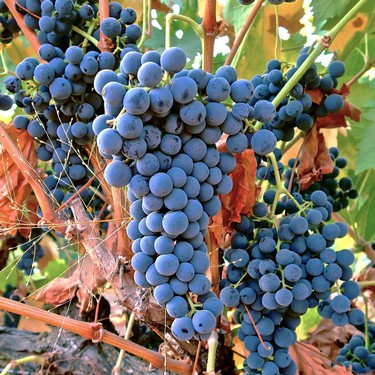
Tempranillo in McCay Cellars' Lot 13 Vineyard, originally planted on the east side of Mokelumne River-Lodi by Alan Kirschenmann in the mid-1990s
In recent years Bokisch Vineyards has also been offering a "Gran Reserva" style of Tempranillo that is aged an extra four years in wood and bottle. The wines have proven to have gained remarkable breadth and structure from the additional tannin and oxidation gained from the extended aging. What this proves is that Tempranillo's tannin structure, which comes across as very round and appealing when wines are consumed young, can be transformed into something much sturdier and longer-lived if kept longer in barrels. Cabernet Sauvignon, Sangiovese, and Mourvèdre are among the few other black-skinned grapes that have proven to be similar to Tempranillo in terms of that flexibility, or adaptation, in their tannin components, producing wines that only gain in strength and muscle when exposed to longer periods of oxidation during barrel aging.
Also in Lodi during the late 1990s, the late Alan Kirschenmann planted a small block of Tempranillo for Mitch Cosentino is one of the sandiest pockets of the Mokelumne River AVA, east of the City of Lodi near the community of Victor. Just a quarter-mile away in a similar sandy riverside site, the Bokischs planted Tempranillo in their Las Cerezas (“Cherry Road”) Vineyard. In the early 2000s. Harney Lane Winery followed up with their own modest block of Tempranillo south of Victor in the ultra-fine sandy soil of Mokelumne River-Lodi's east side.
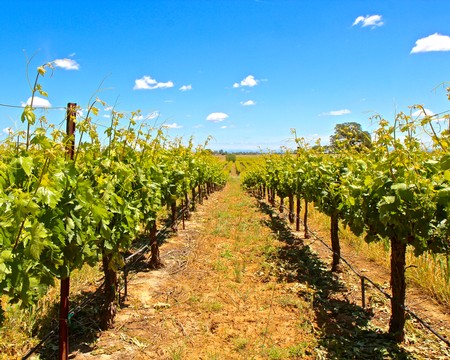
Bokisch Vineyards' Liberty Oaks Vineyard in Lodi's Jahant AVA.
All of these plantings have since matured — particularly the Kirschenmann Vineyard, now bottled by Lodi's McCay Cellars (who purchased the vineyard and renamed it Lot 13 Vineyard), Fields Family Wines, and m2 Wines — and have since proven that Tempranillo can produce perfectly “varietal” (i.e. meaty and dense, and not unlike new leather) qualities in flat, sandy loam sites, as opposed to the rocky clay hillsides traditionally associated with the grape. No matter where you go in the Lodi appellation, of course, the prevailing climate is decidedly Mediterranean, marked by the bright, warm summer days and the cool summer nights. This is the type of climate, not unlike that of Spain's, that Tempranillo absolutely loves.
Perhaps the most phenomenal aspect of red wines made from Tempranillo is that their palate sensations are just as subtle as their aromas, typically giving a gripping feeling of fullness without the burdensome baggage of hard tannin or excessive alcohol. When red wines like this are consumed on their own, these sensory qualities are almost elusive to the senses. But when consumed with food, particularly high myoglobin protein meats, the nuanced varietal character suddenly become more delineated and intense, often in dramatic or surprising fashion.
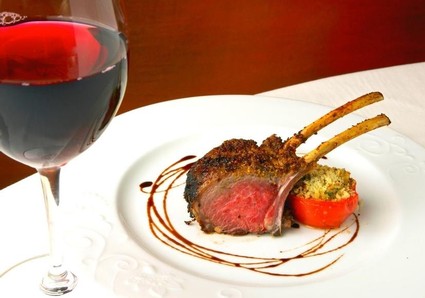
Timeless wine and food match: Tempranillo and lamb. Unraveling Wine.
Let's put this in English (or español): A good Tempranillo can be quite pleasing, in its own low-key sort of way, when sipped on its own. But when tasted in the context of certain foods — especially red meats like rare beef or game — all of a sudden a Tempranillo can taste deeper, fuller, and more expansive in flavor. Even the aromas in the glass seem to intensify. A trick of the senses? Not really. It's simply that our olfactory and tongue receptors are strongly susceptible to sensory suggestions, and red meats act as triggers for the sensory components found in Tempranillo. This is no doubt why Tempranillo-based reds have been held in high esteem for centuries in Spain's Rioja, Ribera del Duero, Toro, La Mancha, and Catalunya regions. It just took us dumb Americans a lot longer to catch on to the grape's culinary magic.
Bokisch Vineyards co-owner Liz Bokisch, for instance, loves to suggest her Tempranillo with pork tenderloin or chicken mole; but you may find Tempranillo characteristics to be even more distinctive when tasted with dark, rangy meats of muscle-using animals such as lamb, venison, bison, goat, wild pig, goose, duck or squab.
But perhaps the most magic happens when Tempranillo-based reds are served with lamb — lamb chops, roasted legs of lamb, almost any kind of lamb, cooked almost any way. Best yet, it doesn’t have to be elaborate — it can be as simple as ground lamb burgers. As long as the game, grassy taste of lamb is involved, you’ll understand why for centuries many of the world’s greatest wine and food matches have involved copious glasses of Tempranillo.
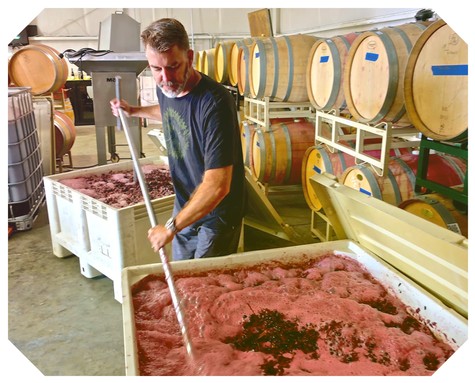
Fields Family Wines co-owner/winemaker Ryan Sherman punching down fermenting Tempranillo.